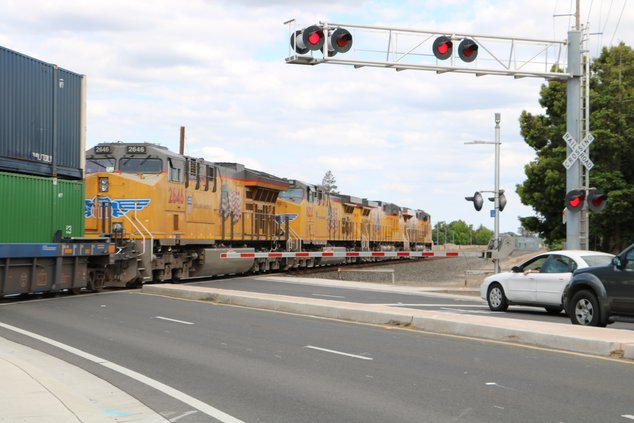Debby Moorhead says the horns of trains as they approach 10 crossings through the heart of Manteca don’t bug her as much as they do some of her neighbors.
The councilwoman who lives in a new Atherton Homes neighborhood southeast of Woodward Avenue and Pillsbury Road concedes it may have something to do with the fact she lays her good ear — she has hearing problems in one — down on a pillow when she goes to bed.
And while some council members including Moorhead seemed eager to see a quiet zone be put in place along the Union Pacific Railroad tracks that would essentially eliminate train horns unless conductors had to warn someone who was on the tracks or who managed to get around crossing arms, whether the council can even afford to debate the proposal may come down to what 19 other Northern California cities think about the idea.
That’s because Manteca is part of a 20-city joint powers authority that pools resources to provide municipal insurance coverage for all of the jurisdictions.
If there aren’t willing to shoulder the risk, any Manteca council discussion becomes academic unless elected leaders want to go on the open market to find insurance coverage that would be required if Manteca establishes a quiet zone and makes necessary improvements.
The insurance is required because deviating from the non-quiet zone Federal Railroad Administration standards significantly increases city exposure in an accident at a quiet zone crossing they create.
Given how train versus vehicle collisions tend to trigger significantly larger lawsuits in addition to the defense costs the city would incur, annual premiums would need to reflect the liability exposure.
Any improvements that would be needed such as placing four crossing alarms and signals at crossings instead of just two and/or a median that can’t be driven over would be on the city’s dime. That can come to $400,000 plus per crossing for signals and crossing arms and $15,000 for median work. The city would also have to cover the annual maintenance costs.
Both Mayor Steve DeBrum and Councilman Richard Silverman made it clear their decision will be driven by costs. Both expressed serious doubt the city could afford quiet zones with Silverman noting beyond one-time costs the reoccurring costs such as for insurance and maintenance would take away from the city’s ability to hire more police officers.
Several residents in the new neighborhood in the triangle bounded by Louise Avenue, Airport Way and the Union Pacific tracks spoke in favor of quiet zones during Tuesday’s council meeting.
All of them acknowledged they knew the railroad tracks were adjacent to their neighborhood but didn’t anticipate the intensity of the horns and the number of trains on the corridor to be as high as it is. The developer during the sales disclosure process also emphasized the neighborhood is along railroad tracks.
Several noted they lived by railroad tracks previously in the Bay Area but the noise wasn’t nearly as bad.
Among their complaints were the horns were disrupting sleep, they couldn’t have windows open, and the horns made it difficult to enjoy their backyards.
A consultant pointed to other quiet zones including one in downtown Sacramento.
What he didn’t note, though, is the trains passing through downtown Sacramento are not traveling up to 55 mph plus.
The corridor through Manteca will see increased trail traffic in the next few years when Altamont Corridor Express trains start rolling through Manteca as well as increased UP right movements. The rail corridor is on target to be double tracked by 2023.
Federal law governs what railroads must do in terms of alerting motorists through the use of train horns.
The Union Pacific Railroad’s website notes that a locomotive’s horns must be sounded for 15 to 20 seconds under federal law before entering all public railroad crossings The Federal Railroad Administration (FRA) required pattern for blowing the horn is two long, one short, and one long sounding horn, repeated as necessary until the locomotive clears the crossing. Locomotive engineers retain the authority to vary this pattern as necessary for crossings in close proximity and are allowed to sound the horn in emergency situations.
The website states “Union Pacific believes quiet zones compromise the safety of railroad employees, customers, and the general public. While the railroad does not endorse quiet zones, it does comply with provisions outlined in the federal law.
“Federal regulations provide public authorities the option to maintain and/or establish quiet zones provided certain supplemental or alternative safety measures are in place and the crossing accident rate meets FRA standards.”
The council instructed staff to further explore costs and liability issues and bring the quiet zone proposal back at a later date.
To contact Dennis Wyatt, email dwyatt@mantecabulletin.com
SILENCING HORNS MAY BE COSTLY
DeBrum, Silverman skeptical Manteca can afford railroad quiet zone expenses




